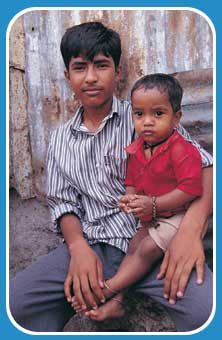| With
birth rates falling nearly everywhere, the "population
explosion" may be fizzling out. Yet half the world's population
is under 25. Even if women of this younger generation have only
two children each, population growth will continue.
Roll your cursor over
the icons to see the UN's predictions for world population
growth depending on different changes in average family size.
As you can see, just a small change in family size makes a
lot of difference...
1.6
children or fewer

|
2
children

|
|
The rôle of
children
Birth rates today are highest in the poorest regions, particularly
sub-Saharan Africa. Although deaths from AIDS may change the
situation, the population of this region could triple over
the next 50 years.
Poor families in sub-Saharan
Africa have good reasons to have more children.
Global Responsibilities
High population growth puts greater pressure on the world's
resources like energy, water and fertile land. But the people
who live in the developed world are part of the problem too.
Today, people in the richest countries consume 86% of the
world's resources even though they represent only a fifth
of the world's population. For example, it is estimated that
one American uses 28 times more energy than one Indian. Some
argue that MEDC
governments should respond by taking more action to change
the way people live in the developed world - for example,
investing more into sustainable practices like renewable energy,
saving water and recycling waste to cut down the rate at which
we use resources.
By force or by choice
The issues may
be global, but ways of dealing with them in the past have
focused on lowering birth rates in the developing world. Extreme
cases of 'population control' have forced women to use contraceptives
or to be sterilized.
 to
get an update on China's form of 'population control' called
the 'one child policy'. to
get an update on China's form of 'population control' called
the 'one child policy'.
In contrast, the Cuban
government has tackled the reasons why poorer people want
children in the first place. By creating a health service
freely available to everybody, Cuba has one of the lowest
levels of infant
mortality in Latin America. Once parents are confident
that their children will survive, they have fewer children
to begin with. At 14 per 1,000, Cuba's birth rate in 2001
was lower than the USA.
Names, not Numbers
Family sizes in
Bangladesh have also fallen even though the country remains
poor. Here, access to 'reproductive health care' has helped
to reduce the birth rate. Whereas 'population control' methods
reduce people to numbers, 'reproductive health care' treats
people as individuals with names, feelings, and the right
to decide if, when and how often they want to have children.
What is 'reproductive health care'?
 to
find out. to
find out.
Girl Power

©Giacomo Pirozzi/Panos
Pictures. |
Contraceptive
education in a village in Swaziland. |
Individual rights and
responsibilities topped the agenda of the 1994 International
Conference on Population and Development in Cairo. In particular,
the improved position of women was recognised as the best
known way of bringing down the birth rate. With access to
reproductive health care and effective education, women are
more likely to have the self-confidence to take charge of
their sex lives, and greater power to plan the size of their
families.
 for an Excel spreadsheet of development data for selected
countries. Find out whether there is any relationship (or
'correlation') between different development indicators like:
for an Excel spreadsheet of development data for selected
countries. Find out whether there is any relationship (or
'correlation') between different development indicators like:
- GDP per capita and
the birth rate
- The birth rate and
the average age of women for their first marriage
- The birth rate and
the % of women using contraception
You can get the computer
to do a statistical correlation or make a scatter graph by
using the correl tool or chart wizard. If you need help with
this,

Speaking out for girl
power, ex-Spice Girl, Geri Halliwell is a spokesperson for
the Face-to-Face campaign to improve the reproductive health
rights of women. Visit www.facecampaign.org
for more.
It takes Two

©O'Leary/Population
Concern |
The Cairo conference
also recognised that men have reproductive and sexual
health needs. Family planning services used to ignore
the part that men played in decision-making about contraception,
making them less likely to behave as responsible partners.
In addition, research and family planning services focused
on female forms of contraceptives even though condoms
and vasectomies for men are easier and safer. But the
problem of STIs,
particularly HIV/AIDS, has given an added push to promote
condoms to prevent the spread of disease, and to cut down
the number of unwanted pregnancies. |
Obstacles Ahead
'Reproductive health care' may be the way forward, but
many people are still denied access, especially young people
and unmarried women. At the Cairo conference, it was agreed
that spending should increase by an extra £10.6 billion
a year to expand reproductive health care. Representatives
from developed countries agreed to pay a third of the bill.
Yet even though we spend more money each year on chocolate
and sweets in the UK alone, the money made available so far
has fallen way below this amount. Further threats to reproductive
health care services worldwide have come from George W. Bush's
first move as US President in January 2001. His government
has reinstated a ban on US funding for any organisation that
offers advice and support on abortions, even if this is only
one of the services that they provide.
Although it may be a
long time before everyone can get the reproductive health
care they need, there has been progress since the Cairo conference.
Go to one of the next pages to find out more.
Other recommended
websites on population issues...
There are many
websites on population issues. Here are a few useful ones:
Visit www.census.gov/ipc/www/idbpyr.html
if you need population pyramids for any country in any year.
www.geohive.com includes
masses of up-to-date data on different countries.
www.dayof6billion.org,
or www.popexpo.net are
two colourful, easy to follow websites that look at population
issues.
www.unfpa.org/modules/briefkit/index.htm:
Here you can download the Population Issues Briefing Kit 2001
written by the UN Population Fund. This will give you lots
of information on population issues including population trends
by region, the impact and prevention of HIV/AIDS and reproductive
health & rights.
For more in-depth information
and statistics on reproductive health care and changes in
population policies, visit:
www.un.org/popin
www.popcouncil.org
www.popinfo.org
www.unfpa.org (choose 'State
of World population' from the top menu)
|





